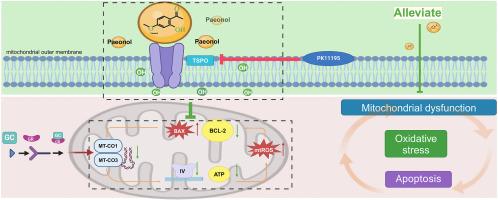The effect of TSPO transmembrane transport-mediated paeonol mitochondrial antioxidant on dexamethasone-induced mitochondrial abnormalities, oxidative stress damage, and apoptosis in SV40-MES-13 cells
IF 3.5
3区 生物学
Q3 CELL BIOLOGY
引用次数: 0
Abstract
Dexamethasone (DEX) can induce pathological kidney injury but is still a first-line therapeutic agent; thus, elucidating the mechanism of DEX-induced kidney injury and developing targeted therapies to mitigate its effects are imperative. The aim of this study was to elucidate the mitochondrial targeting mechanism of the natural plant compound paeonol on DEX-induced mesangial cell injury. To achieve this, we employed RT q-PCR and Western blot analyses to quantify gene/protein expression, flow cytometry for apoptosis assessment (Annexin V/PI staining) and mtROS detection (MitoSOX Red), JC-1 probe for mitochondrial membrane potential (ΔΨm) measurement, and High-sensitivity structured illumination microscopy (HiS-SIM) imaging for ultrastructural analysis. ATP synthesis assays and malondialdehyde (MDA) quantification were used to evaluate mitochondrial function and lipid peroxidation, respectively, while Mn-SOD activity was determined via enzymatic assays. Paeonol counteracted these effects via four mechanisms: restoration of mitochondrial ultrastructure. reactivation of MRCC IV activity, reduction of mtROS and malondialdehyde, and enhancement of manganese superoxide dismutase antioxidant capacity. Crucially, paeonol used the mitochondrial entry mechanism mediated by the translocater protein (TSPO). By blocking the oxidative stress-apoptosis cascade, downregulating BAX, preserving BCL-2, and inhibiting cytochrome c efflux, the early/late apoptotic population was significantly reduced. This study confirmed that TSPO-mediated intra-mitochondrial antioxidant paeonol alleviates DX-induced mitochondrial dysfunction, oxidative stress, and apoptosis in SV40-MES-13 cells.

TSPO跨膜转运介导的丹皮酚线粒体抗氧化剂对地塞米松诱导的SV40-MES-13细胞线粒体异常、氧化应激损伤和凋亡的影响
地塞米松(DEX)可引起病理性肾损伤,但仍是一线治疗药物;因此,阐明dex诱导肾损伤的机制和开发靶向治疗来减轻其影响是势在必行的。本研究旨在阐明天然植物化合物丹皮酚对dex诱导的系膜细胞损伤的线粒体靶向机制。为此,我们采用RT - q-PCR和Western blot分析来量化基因/蛋白表达,流式细胞术用于细胞凋亡评估(Annexin V/PI染色)和mtROS检测(MitoSOX Red), JC-1探针用于线粒体膜电位(ΔΨm)测量,高灵敏度结构照明显微镜(HiS-SIM)成像用于超微结构分析。ATP合成测定和丙二醛(MDA)定量测定分别用于评估线粒体功能和脂质过氧化,而Mn-SOD活性通过酶促测定。丹皮酚通过四种机制抵消这些影响:恢复线粒体超微结构。MRCC IV活性的再激活,mtROS和丙二醛的减少,以及锰超氧化物歧化酶抗氧化能力的增强。关键是,丹皮酚利用了由易位蛋白(TSPO)介导的线粒体进入机制。通过阻断氧化应激-凋亡级联,下调BAX,保存BCL-2,抑制细胞色素c外排,可显著减少早期/晚期凋亡群体。本研究证实,tspo介导的线粒体内抗氧化剂丹皮酚可减轻dx诱导的SV40-MES-13细胞线粒体功能障碍、氧化应激和凋亡。
本文章由计算机程序翻译,如有差异,请以英文原文为准。
求助全文
约1分钟内获得全文
求助全文
来源期刊

Experimental cell research
医学-细胞生物学
CiteScore
7.20
自引率
0.00%
发文量
295
审稿时长
30 days
期刊介绍:
Our scope includes but is not limited to areas such as: Chromosome biology; Chromatin and epigenetics; DNA repair; Gene regulation; Nuclear import-export; RNA processing; Non-coding RNAs; Organelle biology; The cytoskeleton; Intracellular trafficking; Cell-cell and cell-matrix interactions; Cell motility and migration; Cell proliferation; Cellular differentiation; Signal transduction; Programmed cell death.
 求助内容:
求助内容: 应助结果提醒方式:
应助结果提醒方式:


